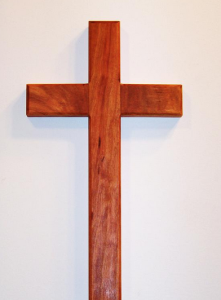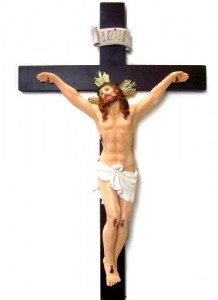The Cross & the Crucifix
(From a letter Steve wrote to a Evangelical Protestant who asked about the Catholic Crucifix)
Dear Evangelical Friend:

As an Evangelical Protestant I rejected the crucifix, as you do—Christ was no longer on the cross; he had ascended into heaven. So why do I now tremble in love and awe at the site of a crucifix? Let’s examine the history and issues surrounding the two.
I will provide a brief overview of the Cross and the Crucifix, the origin, the history, and the differing perspectives of Catholic and Protestant. It will try to catch the historical flow and include the pertinent points. The outline is as follows:

2. Images and Gods in the Old Testament
3. Images and Images of Christ in the New Testament
4. The Cross in the First Centuries
5. The Crucifix Enters the Picture
6. The “Reformation” and Iconoclasm
7. Modern Anti-Catholics and the Crucifix
8. Ecumenical Considerations
To read the whole article, click here. To read Steve’s other articles, click here. For Steve’s talk “The Pain of the Crucifixion,“ click here.



This Post Has 5 Comments
Pingback: Defenders of the Catholic Faith : Hosted by Stephen K. Ray » Triumph of the Cross
I have a simple apologetic to the cross namely, “We preach Christ crucified: a stumbling block to Jews and foolishness to Gentiles. Which one are you?”
When said with a good natured smile and not trying to belabor the point since we both know they are neither (just confused), that’s usually enough to satisfy this objection and move on to the next one.
Thank you for the well informed article on the Catholic Church. There are many facts which are correct and as all Catholics know that the crucifix and statues of saints are reminders of the sacrifice of the greatest sacrifice to save our souls and not an idol to worship. The statues of saints are to remind us of those who have been verified by the Catholic Church as saints in heaven. Does that mean we worship false idols, no. On the contrary, we pray to the saints to help pray for us when we are in need and never to pray for vengeance or ill will to others. It’s the same as asking for people to pray for you or others that need God’s help. Catholics don’t believe those who have passed on are dead; more like their very much alive in the spiritual sense.
There is no one symbol outside the church that represents we are Catholic. I do not stand in public places and form prayer circles to let everyone know I’m a Christian, but I show my faith through acts of service. Yes, I do wear a cross around my neck, but it is not a crucifix. I do this to let people know what I believe in.
The only item that I disagree with in this article is the accounts made of Protestants during the time of rebellion. The Protestants rebelled against the Catholic Church due to the wealth and status given to the representatives of the church. Hensley they destroyed the churches and stole the property to support the people in a time of great poverty. I took a pilgrimage of the UK while stationed there. There the ruins of churches are you can see the sand stone blocks integrated into the buildings in the surrounding village. The Protestant church was formed from the protesters, hence the name Protestant. I had the privilege to attend churches of other faiths and found that many have the same rituals and songs as the Catholic Church. The only churches I attended that made me feel uncomfortable were the churches that had ministers that acted like televangelists guilting their parishioners into giving most of their money to spread the word of God, all the while dressed to the 9s and flaunting their wealth.
I highly recommend people ask their Catholic friends to attend mass and find out for themselves if there is any secretive occult activity going on and have them introduce you to the Priest, he’s just a man.
Great post Steve, very informative.
George
Australia
I agree the priest is only a man! Hoever a man that has been ordained and given the power through the Holy Spirit to change bread and wine into the Body and Blood of Christ..
Comments are closed.